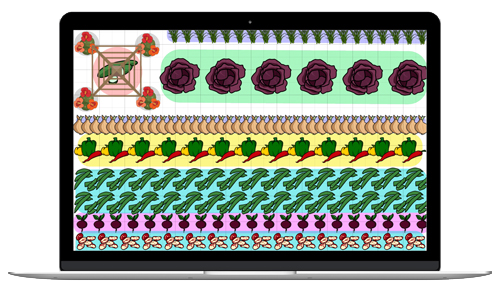
Rhododendrons are popular among gardeners with their evergreen shrubbery and early blooms.
Planting, Growing, and Pruning Rhododendrons and Azaleas
The Almanac Garden Planner - Use It Free for 7 Days!
Plan your 2025 garden with our award-winning Garden Planner.
There are more than 900 species in the Rhododendron genus, which vary greatly. It would take a whole book to understand this wide world!
You may be interested in joining the American Rhododendron Society, which runs a database with information on more than 2,000 rhododendrons and azaleas. On an annual basis, the society selects a number of rhododendrons to be awarded the Rhododendron of the Year designation, highlighting the best-performing plants for different regions.
Here is a handful of varieties that we think you’ll enjoy:
- ‘Blue Diamond’ is a dwarf evergreen rhododendron that grows to 3 feet. It blooms mid-season with violet-blue flowers. Zones 7 to 9.
- ‘Cecile’ is a vigorous azalea that grows to 7 feet and produces dark salmon-pink buds in mid-season. Zones 5 to 8.
- ‘Hydon Dawn’ is a low-growing rhododendron that actually tolerates full sun. Pale pink flowers bloom in mid-season. Zones 7 to 9.
- ‘Nova Zembla’ is an evergreen rhododendron that grows 5 to 10 feet tall and bears bright red flowers in late midseason. Zones 5 to 8.
- ‘Rosy Lights’ is an azalea that offers extra cold hardiness. It grows to 6 feet and bears deep purple-pink flowers. Zones 3 to 8.
- ‘Purple Gem’ is a dwarf rhododendron that grows to 2 feet and is an early-season bloomer. It bears small, light purple flowers. Excellent in front of a border or in a rock garden. Zones 5 to 8.
ADVERTISEMENT
My rhododendron do not have colorful pink flowers. I have a problem in that individual branches are getting covered with a white film. Then the leaves turn brown and the branch is dead. I've been cutting out these dead branches. But my bushes now have large bare spots. With what should I treat them? Thank you.
Hi, Martha: Sounds like you have powdery mildew. Go here to read about it and learn about remedies: http://www.almanac.com/pest/powdery-mildew. Then, contact your local USDA county extension office/agent to find out whether there is more helpful information specific to your locale. You can find your agent here: http://www.almanac.com/content/cooperative-extension-services. Good luck, and thanks for asking!
we took a new shoot from an old rhodoendron and its about a foot high and looks very healthy but is covered in tiny green flowers what do we do with this plant will it bear normal flowers not sure
Most rhododendrons take 2 to 3 years to bloom from a rooted cutting unless forced. Some take longer and some bloom sooner.
I need to see pics of what the plant looks like in the winter - can you help?
I have two azalea plants that are not showing any sign of life. Is there a change that if I take them down to the ground they may come back? Am I looking at replacing two plants?
It’s hard to know exactly what’s going on here. Our initial consideration would be soil quality and the pH value of it; see above in “Planting” for more details. (Notice the moisture and sun requirements, too.) Poor/improper soil is the —er—root cause of many plant problems. Cutting these down will not make any difference if they are not healthy now. And replacing them with two is unlikely to result in the outcome you want if you do not check and/or address the soil conditions. Putting different plants in this same space is not the answer either; each plant has particular needs (yes, some needs are common to many plants, but speaking in generalities here, you can not bank on different plants being the solution).
Sorry we do not have better news. The good news is that this situation is “fixable” is you test your soil and amend as needed.
planted three encore autumn twist azaleas side by side a few weeks ago. the one in the middle is still green robust, but one of them on the opposite of it is questionable. one has brown leaves that have dried and curled, but I scratched the stems a little to check if they are still green, and they are. Is that normal?
Hi, Brad, It certainly does not sound normal, especially if you have a healthy plant to compare it to. You do not say where you are geographically, but we presume somewhere south, somewhere where there is no “winter,” because you were planting weeks ago. But just in case you are not, that—the early planting—may be part of the problem. Your plant may be suffering from “winter injury”—extreme temperature fluctuations, excess dryness (evaporation from the leaves, not just at the root) at a time when the plant is not prepared to take up water/moisture because the ground is still frozen or moisture is unavailable to the roots. Newly planted/transplanted shrubs are susceptible to this.
It’s also possible that, strange as it may seem, the conditions in the soil were different from the one plant.
Since it sounds like you planted recently and, we’re guessing, purchased the plants recently, you might consult the nursery/source from which you got it. If not too much time has passed, they might replace it. Bring picture, or bring the plant, to them (with your receipt) and see what they say.
We hope this helps!
winston salem, nc its believed to be winter damage. planted in january, and it got really cold and snowed right after i planted the problem plant. currently stems are still very green when scratched. Will probably leaf out when there is a steady warm as the seasons progress.












